The fifth day was probably the most eventful day of our trip. We had to travel just about 50 km from Tabo to Kaza on this day, hence, we ended up seeing and doing a lot of stuff starting with exploring the village of Tabo itself. Tabo is mainly famous for two things – a 1,000 year old monastery and a few old caves carved into the face of a hill. The monastery was located in the village while the caves were located on the other side of the highway. These caves are also hundreds of years old and were used by monks for lodging and meditation purposes. Fortuitously, there was a set of stairs in our hotel compound which led straight to the caves.
TABO MONASTERY & CAVES
We left our hotel at 8 am and navigated through the narrow alleys of the village to reach the monastery. There was an information board at the entrance of the monastery from which we came to know that the Tabo monastery was founded in 996 AD and is known as Ajanta and Ellora of the Himalayas due to its old and beautiful paintings. We went inside and saw a fairly large complex which contained numerous stupas, temples and other structures. The temples were closed at that time and were scheduled to open after 9 am hence we moved to the adjoining complex which consisted of newer structures that included a large stupa and an under construction monastery building.


As the clock ticked past nine we returned to the Tabo monastery. By this time few of the ancient temples were opened and we spent the next half hour exploring these temples and marvelling at the paintings and sculptures inside. Some of the paintings inside the temples were quite beautiful but they looked faded and in need of restoration.
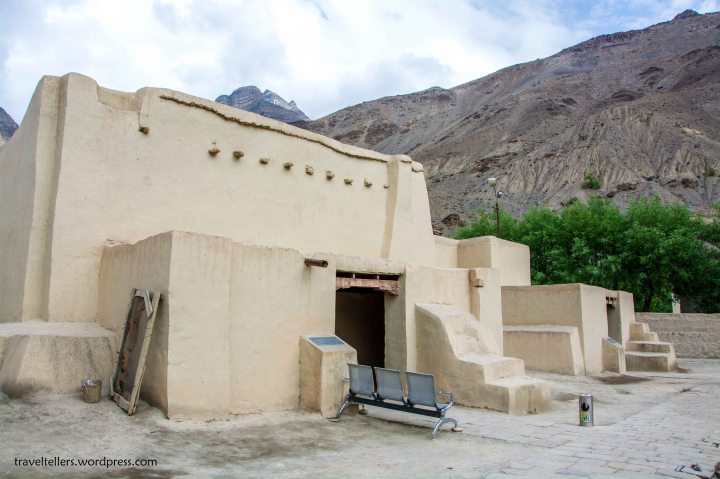


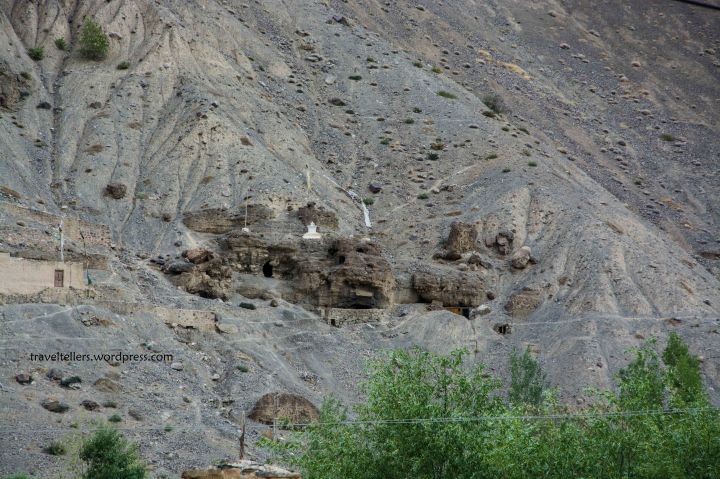
After exploring the monastery we walked back to our hotel. While the others made their way to the breakfast table, I wanted to see the caves so I took those stairs in our hotel compound and climbed up. What I learnt that day was that if you take the pains of climbing a mountain, you would always be rewarded. I was rewarded with a spectacular view of the valley. In front of me was a small village, an old monastery, large green fields, a river and all of them surrounded by spectacular, majestic, barren mountains on all sides. It was simply breathtaking.



After absorbing this view, I continued towards the caves. I finally reached a small building made of mud, stone and timber which was built into the hill. The entrance to this building was bolted and a sign outside said that it is protected by the ASI. The caves were some distance beyond this building. While the path to the building was paved, the path beyond it consisted of only narrow muddy trails. I pondered for a few minutes whether I should make my way over to the caves but then decided that it was not safe, particularly as I was alone. As I turned back, I saw an old woman coming towards me signalling me to wait. Once she arrived, she unbolted the doors and asked me to come inside. There were two chambers and another locked room inside the building. She unlocked that room and asked me not to take any pictures. That room also contained paintings like those we had seen in the monastery. I thanked her and left. As I looked back a few moments later, I saw her sitting outside the building already immersed in her prayers. This place just had a different feel to it, something one can never experience in cities.

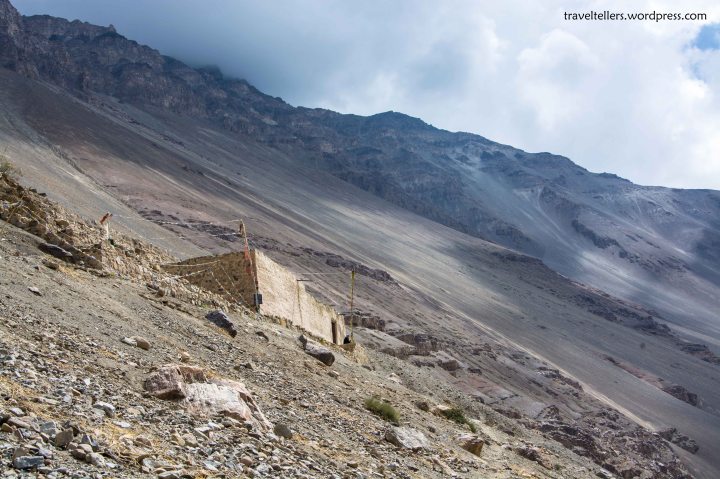
I quickly climbed down and saw that my friends were done with their breakfast and were ready to leave. I too quickly had my breakfast and we finally left Tabo by 10:30 am.
ROAD TO DHANKAR
After travelling for approximately 20 km, we reached Sichling village from where a detour of 8 km got us to Dhankar – our final halt before Kaza. The road to Dhankar was in a pretty good condition and it took us about 75 minutes to reach our destination.
DHANKAR (3,890 m)
Dhankar village was one of the most unique villages we had ever seen in terms of layout. Majority of the mountainous villages that we had come across till now were mostly built on flatter ground with houses and other buildings clustered together. By contrast, Dhankar had a semi-bowl like layout with the buildings quite spread out. Many of the houses looked like they were jutting out from the sides of the mountain itself.

The next thing worth mentioning about Dhankar is the views it offered. In fact, it would not be an exaggeration to say that Dhankar offered us the best views of our entire trip. The village was built on a ridge and looked over the spectacular confluence of Spiti and Pin rivers down in the valley. When we were eventually able to tear away our gaze from the confluence we were met with another amazing sight of clouds covering the peaks of the mighty mountains that rose above the rivers. To add a touch of mystique to this surrounding were some strange rock formations. These captivating views became more pronounced once we began our trek to Dhankar Lake.

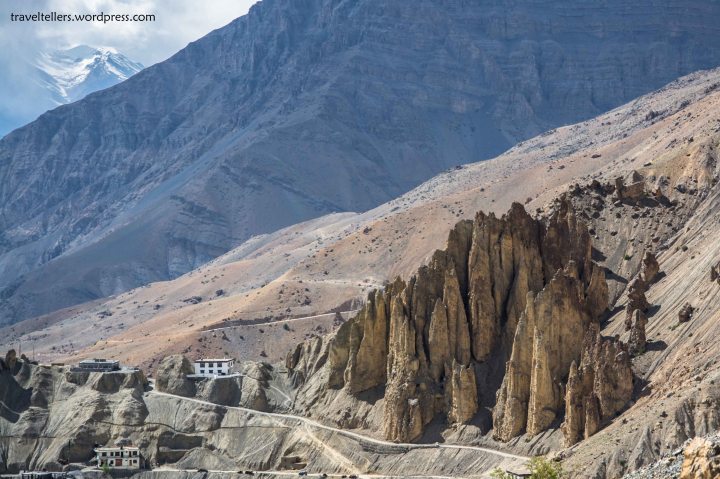
TREK TO DHANKAR LAKE
Dhankar is primarily known for two sights – a monastery and a lake. We arrived at Dhankar and parked our vehicle at the entrance of the village which incidentally was also the site of the new Dhankar monastery. The old monastery was on the other side of the village and looked pretty far from where we were standing. On the other hand, reaching the lake was also not easy and involved a steep trek. We discussed on where to head first and quickly decided on the lake since we had already seen a monastery in the morning and had missed Nako Lake the previous day.
We started the trek at 12 pm and followed a well defined trail to the top passing through the barren and dusty mountains. As we climbed higher, the view of the village and the surrounding area looked even more striking but we decided to take photos only while coming down. The trek itself was quite taxing and we had to stop many times to catch our breath before plodding on further. After climbing almost 300 m in 1.5 hours we reached a large stretch of flat land surrounded by mountains on all sides and situated at one end of that flat land was the Dhankar Lake.

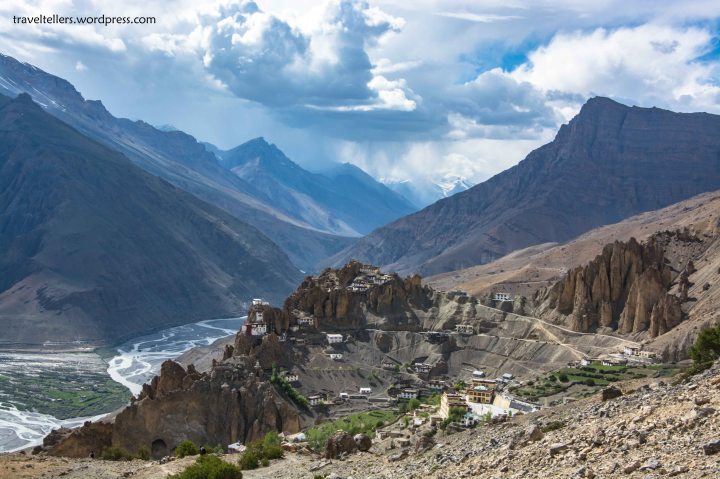
The lake was not very large but the water was quite clean. Patches of grass surrounded the lake which explained the presence of cattle at such height. There were also a couple of small stupas built close to the lake. We spent some time sitting by the lake and enjoyed the soothing ambience after which few of us decided to dip our feet in the cold, refreshing water of the lake. We spent around 1.5 hours at the site and then began our descent back to the village. After coming back we did not have the energy to walk up to the monastery so we freshened up at a local restaurant and left Dhankar by 4 pm.



ROAD TO KAZA
Our next and final stop, Kaza, is the capital of Spiti Valley. The 35 km journey from Dhankar to Kaza did not take us long and by 5:15 pm we had reached our hotel. Finally, five days after leaving Chandigarh and having travelled for almost 600 km, we reached our final destination.
Our day 4 route in brief: Tabo (10:30 am) ->Dhankar (11:45 am)
Dhankar (4 pm) ->Kaza (5:15 pm)

KAZA (3,650 m)
Kaza was without doubt the biggest town that we had stayed at till that point of our trip but it was still quite peaceful and did not have the crowds that one might associate with typical hill stations. We passed a large monastery on the way to our hotel but decided to visit it later as we were going to stay in Kaza for two more days. After we reached our hotel everyone was too tired and slept off but Vijay and I decided to explore the town a bit. We walked around in diminishing light and reached one end of the town from where we could see the Spiti River flowing serenely in the valley. By this time it had become quite dark and we decided to head back to our hotel and eventually called it a day.
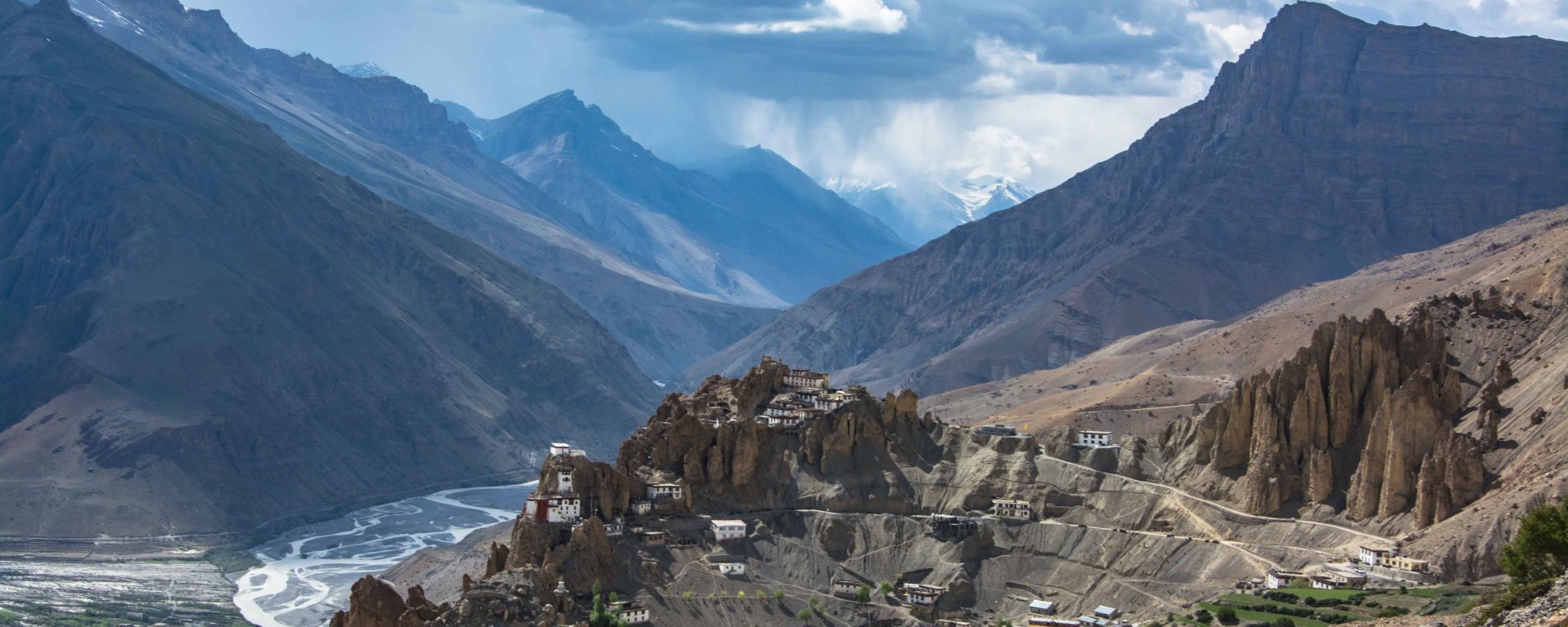


Wow these views are indeed stunning!
LikeLike
I couldn’t agree more 🙂
LikeLiked by 1 person
great posts…beautiful pictures!
LikeLike
Thank you 🙂
LikeLike
I am really enjoying the story of your journey with those excellent photos and description. I marvel at the altitude of the some of the villages you visited. Almost 4000 m! The only lush green can be found around the settlements. There is very little that grows on these high mountains. Thank you for sharing your wonderful experiences!
LikeLike
Thank you Peter. As we progress on our journey the altitude of the villages get still higher. You will get to read about it in our next two blogs 🙂
LikeLiked by 1 person
These are spectacular villages and I am glad you are sharing these because I have not come across tales of visiting them from anyone else.
LikeLike
Thank You. As we wrote in one of our posts, we are really surprised why this region is not so popular among tourists despite having a similar landscape to Ladakh. But the tourism is surely picking up in Spiti too.
LikeLike
It is truly something to think about. Because it has this stark, surreal beauty.
LikeLiked by 1 person